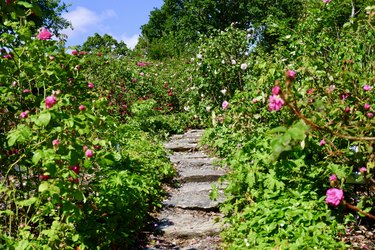
Everyone knows that a path is primarily a way to get from point A to point B. Without a path, you might get lost, get stuck in some mud, or wade into blackberry thorns or poison ivy — ouch. So paths are useful, of course.
But a garden path ... that's a different story altogether. A path in a garden can lead to your compost bin (useful but unexciting), or it can lead to an area of your garden that is perhaps somewhat hidden and therefore enticing.
Video of the Day
Video of the Day
A "garden room" design, in which a garden is laid out into separate rooms, or areas, is especially conducive to pathways because a path is a perfect and sometimes necessary segue between spaces. And these in turn create drama and excitement because their destination is unknown.
In fact, you can design a pathway that leads to a hidden escape, combining the best of both path design and garden design.
Garden Paths Invite Exploration
You know how funny it is to see an arbor just hanging out in the middle of someone's front lawn with a vine climbing up it? What's it doing? I am always puzzled about the purpose of these isolated arbors that don't lead to anything. Are you supposed to randomly walk under it, heading nowhere?
An arbor like this is crying out for a path. Pathways in gardens are routes to adventure, and they frequently wind under an arbor, through a gate, alongside a profusion of plants, toward a focal point, and ultimately to a destination, perhaps unseen. They are an invitation to explore.
You will typically have a path leading from your front yard to your backyard through a gate. If the backyard is somewhat hidden, the path will create drama.
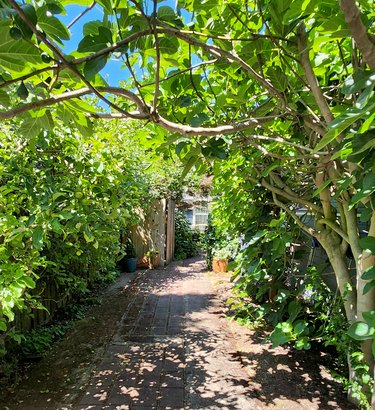
Where to Put a Garden Path
Your garden design will ultimately inform the need for paths, and there are many places to put a path. If you are just starting your landscaping project, you can do some advance planning that incorporates paths into certain areas of the garden.
In particular, if your garden is to be broken into different areas, i.e., garden rooms, then pathways become integral to your design, connecting one garden room to another, drawing in a visitor, and often leading to a focal point, such as a statue or fountain.
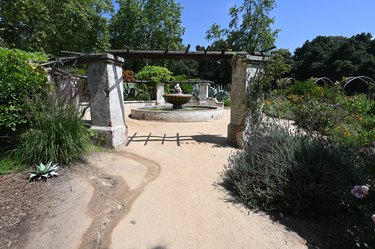
For example, you may have a slope in your backyard. You could design it with a rock path snaking up the bank and perhaps heading somewhere unseen.
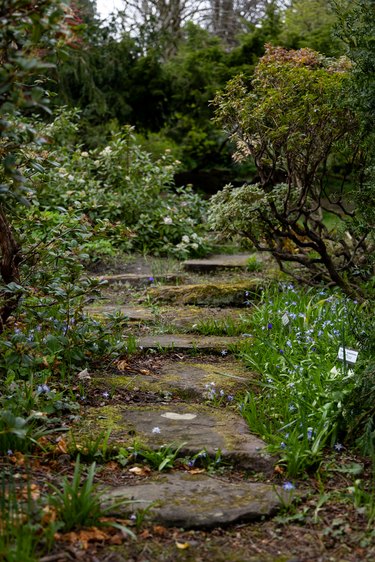
Or your yard may naturally lend itself to be broken up into areas, such as designing a separate area for fruit trees, for dining, for sunning by a pool, or for gathering around a fire pit. You might have a garden shed, a tool shed, or even a small structure for creative pursuits, such as art, writing, or yoga — I can wish!
You'll need a nice path to get you there.
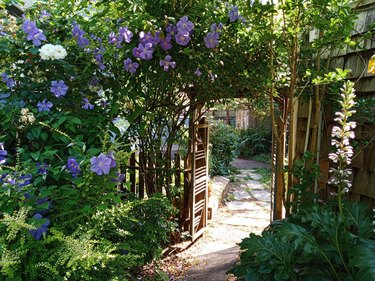
Adding Garden Paths to Enhance Perspective
If your garden is designed on an axis with geometric lines that draw the eye, your paths will enhance those perspectives. If so, you will have one or more vistas, probably based on the view from a back porch or door.

In a large garden, you might have additional connecting paths from a primary central path, each leading to an area invisible from the main path. This is a design often used in formal gardens.
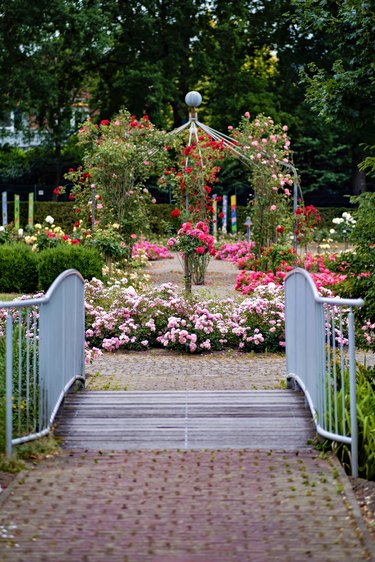
These types of paths can be made of almost any material and in fact might just be lawn bordered on both sides by edging or flowers.
Designing a Garden Pathway for Intrigue
Few things are more pleasing to the eye than a path that ends in a focal point, such as a fountain, statue, bench, or specimen planting.

Enhance your path with some hardscape, in particular arbors under which a path can lead, but also gates, rock or brick edging, or trellises along the route.
This path is lined with decorative, upright posts, providing an architectural element that helps define the path and anchor the profusion of flowers and foliage.
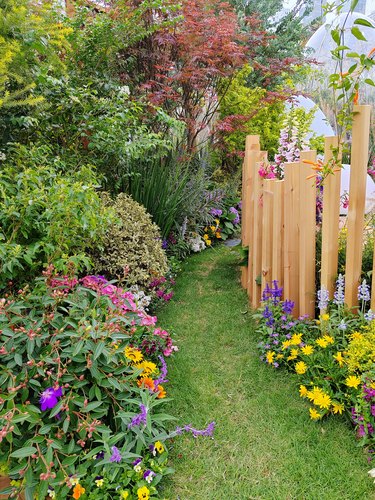
Among the most pleasurable paths to travel are those that lead to a locale just out of sight, or shall we say, to a "hidden escape."
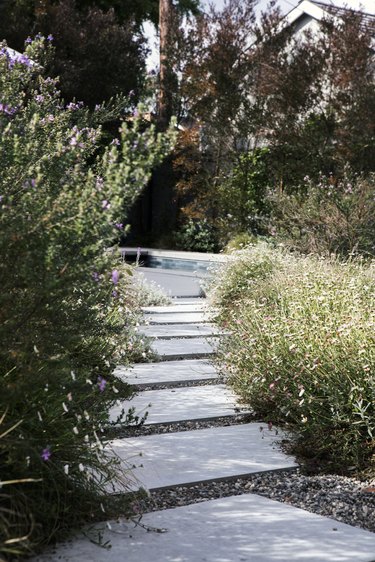
Designing a Garden Pathway
When designing pathways, multiple considerations come into play, some practical and some decorative.
What shape will it take? How wide will it be? Will it be straight, taking the shortest route to its destination, or will it be curved and meandering to provide more visual interest?
How might it complement your garden design as well as your home design?
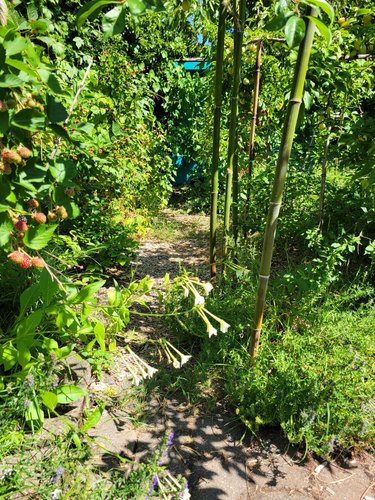
What Shape Will Your Pathway Take?
The shape of your path will likely be dictated by practical considerations. For example, if this is a path that will be traveled by a wheelbarrow, it will need to be wide enough and smooth enough to maneuver and to allow the wheels to roll easily. Similarly, if your path leads you on a stroll through flower beds and arbors, you might want a somewhat wide path so you can share it with others.

How Direct Should Your Pathway Be?
Does your path mean business? If so, you probably want the shortest and easiest route to travel. If you're bringing in groceries from the driveway to the back door, you won't want to meander through the yard smelling the proverbial roses. Make your path straight, simple, and easy to traverse.
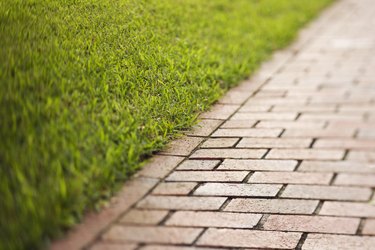
If you're headed to a private spot in the yard somewhere and your garden layout allows it, make your path meander through some flowers, around a tree, or along a water feature. Why not?
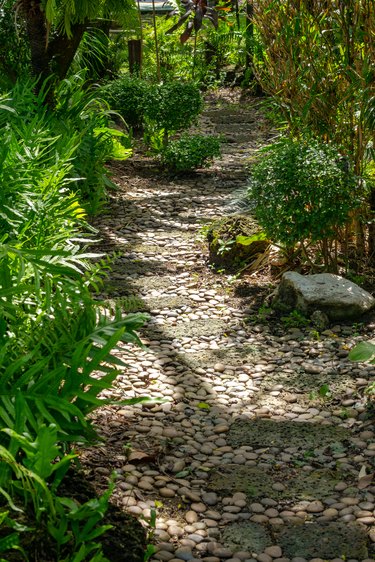
Creating Your Garden Pathway
Once you have a good sense of your design and location, the next step is choosing the materials, so this is when it gets concrete (pun intended!). When choosing materials for your path, consider these issues:
- The amount of traffic the path will receive
- The design or look you're going for
- The cost
- The maintenance
Pea Gravel Paths
Pea gravel is good for almost any path, as it's fairly inexpensive, simple to apply, and easy to walk on or roll a wheelbarrow across. Depending on the surrounding landscape, it can complement a more formal design or a cottage garden profusion.
It can, however, become a weed bed, so it will need maintenance over time.
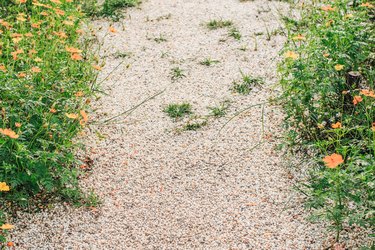
Brick Paths
Brick is a go-to path material, and there is a plethora of sizes and designs from which to choose. If you choose a more rough-hewn design, be sure it's level enough to walk on safely. You might find used bricks at various recycling sites in your area, on Craigslist or Facebook, or at garage sales, so this doesn't have to be an expensive option.
Installation can be a lot of work, but it's pretty maintenance-free after that.
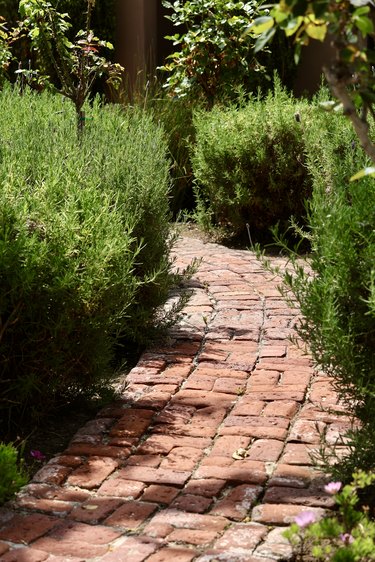
Stone Paths
Stone is such a lovely material, and it can be combined with gravel for an interesting option. It also invites creativity, as you might create mosaics or designs that can provide pleasure for many years.
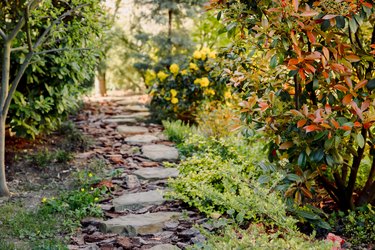
These flagstones sit amid pea gravel, an easy-to-create path but a somewhat expensive option, though you might find used flagstones if you are not in a hurry.
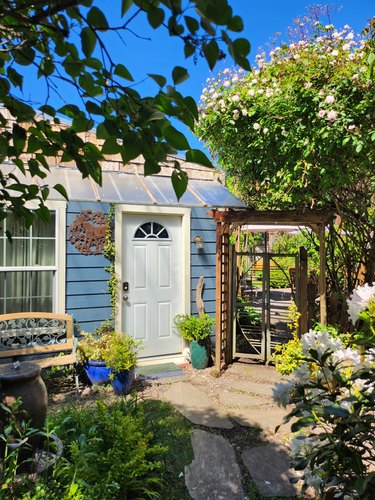
Wood Bark Paths
Among the easiest to create, these paths are also inexpensive. They are, however, high-maintenance since the bark can be washed away, blown aside, or weed-filled.

Safety Considerations
Whatever material or design you choose, make sure you are not creating hazards. You want to ensure a level, even walking surface.
For instance, this path looks pretty dicey to me.
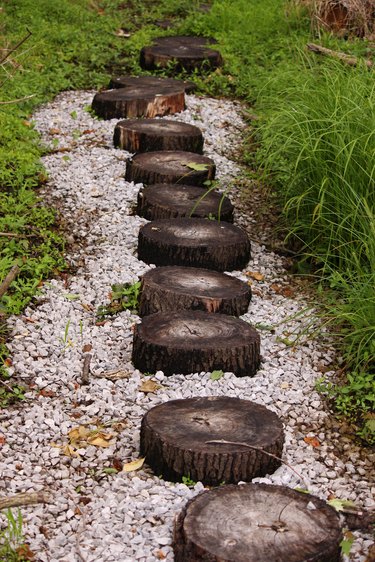
If your path is on a slope, it obviously won't be level, but you can still ensure that its design incorporates obvious steps or stones that are well spaced and solidly laid.
